CFIT Gangnam Style – Korean S-76C++ and Decision Making (HL9294)
Despite poor visibility the crew of an executive helicopter pressed on and collided with a 39 storey building in Seoul.
The Korean Aviation and Railway Accident Investigation Board (ARAIB) have issued their report into the accident that took place on 16 November 2013 when, a Sikorsky S-76C++ HL9294, operated by LG Electronics, crashed into a residential tower block in the Gangnam district of Seoul.
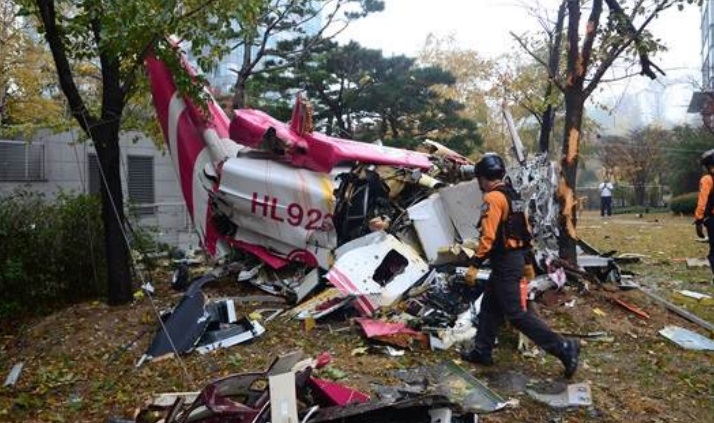
Wreckage of LG Electronics Sikorsky S-76C++ HL9294 at the Foot of the Condominium Building (Credit: ARAIB)
Preparations for the Flight
LG Electronics has a Business Support Office under which there is a Private Jet Team and a Helicopter Team (effectively two separate flight departments).
The helicopter was scheduled to position from Gimpo Airport to pick up six passengers, including a Vice Chairman and CEO of LG Electronics, at the downtown, riverside Jamsil Heliport at 09:00 and take them to a company factory.
This flight had been booked with 23 hours notice.
Investigators say:
…on 16 November, about 06:06 and 06:08, the captain called Gimpo Airport Weather Office and Seoul Airport Weather Office at home and checked out weather conditions, respectively.
About 06:25, he called the [First Officer] FO and said, “Let’s cancel the flight because it will be difficult.” Subsequently, about 06:30, the FO called LG Electronics’ Vice Chairman & CEO’s Office and notified no-go due to bad weather conditions, and according to the statement of the Office, about 06:32, the Office called the Helicopter Team’s pilot in charge of operation and said, “The FO notified no-go, so please, accurately assess a situation once again.”
On the day of the accident, passengers were actually considering two transportation options, high-speed train (KTX) and helicopter…
…[the] passengers [had] already purchased tickets for a high-speed train and thus, were all prepared for a no-go situation…
In subsequent interview it is suggested that:
The reason why LG Electronics’ Vice Chairman & CEO’s Office asked the pilot in charge of operation to reassess a no-go situation is that there was time before the departure of an alternative transportation means, KTX, and that the pilot in charge of operation usually did this job whereas the FO was newly hired.
The pilot in charge of operation suggested in a subsequent call with the pilot and other: “How about taking off at Gimpo Airport if the weather conditions are poor since takeoff is possible (at Gimpo Airport)”? He also gave the deputy general manager the pilots phone number.
…when [the captain] talked with the Vice Chairman & CEO’s Office’s deputy general manager over the telephone at 07:12, he overturned his initial decision and deferred it until 07:40…
As that time approached:
…the captain decided to go forward with the operation as originally scheduled and notified this to the deputy general manager by telephone about 07:38 as well as the pilot in charge of operation through the [First Officer] FO.
The FO checked weather conditions with the Jamsil Heliport’s manager by phone four times (at 07:08, 07:10, 07:52, and 08:13). He was reportedly told: “Due to fog, Cheongdam Bridge (about 1.1 km) is not visible from the heliport, and nor is the Hangang’s water (about 90 m)” …
…but this was not taken into account in the captain’s decision-making process.
About 08:20, the captain went to the ramp for flight where the FO was standing by after the preflight inspection.
At 08:43:53…the captain requested the Tower to clear the flight for takeoff…, and at 08:44:01, the controller advised him that visibility was 700 m. Accordingly, the captain made a request for Special VFR at 08:44:10, and the clearance for takeoff was issued at 08:45:17.
ARAIB report that in post accident interviews at LG it was stated that:
Before the event, the captain had past experience of flying below the allowable limits of weather conditions before the accident.
When other pilots found that the captain decided to fly below the allowable limits of weather conditions before the event, they thought that “the Team leader (captain) was able to conduct a flight under these weather conditions since he had more flight experience and better pilot proficiency than other pilots.”
A final go/no-go decision lies with the captain, and the captain’s decision is fully followed.
The Accident Flight
The helicopter took off at 08:45:31 with the intention of routing down the Hangang River to the city centre heliport.
At 08:46:33, the controller asked, “How’s flight visibility?” The captain said to the FO, “Tell him over 500 is 7 miles!” The FO replied to the controller, “7 is maintained over 500,” adding “We are heading to Jamsil Heliport along the Hangang.”
From then on, the captain and the FO sustained a conversation like “Hangang in sight?,” “Not in sight,” etc. and piloted the aircraft at about 1,170 – 1,350 ft at a speed of about 130 kt on a heading of 120° in the autopilot mode, to Noduelseom (Isl.), along the Hangang.
According to Seoul Airport’s radar data, however, HL9294 started to fly straight after passing by Noduelseom at 08:50:34…
It is at this point the aircraft started to deviate from the planned route close to the south edge of the Hangang.
Then, it turned left and flew in parallel with the Hangang, about 1 km south of the south edge.
As the captain decreased speed for landing, about 3.6 km west of Jamsil Heliport, the FO ran the before-landing checklist and extended the landing gear at 08:52:15.
At 08:52:47, the helicopter over flew the Dosan Park Intersection at 1,360 ft at a speed of 97 kt. The helicopter then slowed, started to descend and turned right.
…at 08:53:32, the flight track of HL9294, maintaining at 800 ft at a speed of 68 kt, disappeared from the radar screen of Seoul Airport.
Then, 11 seconds later at 08:53:43 (based on FDR data), the left side of HL9294 crashed into the north side of the 25th floor (97 m, 320 ft) of Condominium A’s building 102.
The 39 storey building in the I-Park Complex was 179 m, 590 ft high. Both crew were killed, the aircraft destroyed and 13 apartments damaged. Fortuitously no third parties were injured.
Enhanced Ground Proximity Warning System (EGPWS)
The helicopter had been voluntarily fitted with a Honeywell EGPWS. As ARAIB explain:
EGPWS displays terrain and obstacles in proximity of the aircraft, in a grid shape, on the cockpit instrument panel. It denotes in colors, the difference between height of the highest obstacle in a grid and aircraft altitude.
Obstacles of the EGPWS data are marked by different colors according to their heights, on the cockpit instrument panel, i.e. an obstacle higher than the aircraft is displayed in red. EGPWS provides an aural alert to flight crews when the aircraft reaches a distance in danger of crash.
In addition, the computer installed on EGPWS compares its 3D terrain and obstacle data with the aircraft’s altitude, speed and direction, thereby predicting a danger area, and 20 seconds before the aircraft reaches the danger area, it provides aural and visual alerts by changing colors on the pane
The EGPWS did not alert as the helicopter flew towards the 39 storey building. So why did it not alert? Simple say the KARAIB: The database contained the earth surface and electricity pylons, but no other man-made obstacles, like the 179 m, 590 ft building!
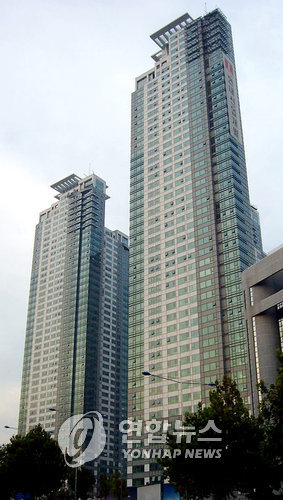
I-Park Condominium Complex (Credit: Unknown)
Analysis of Go/No-Go Decision Making
The ARAIB say:
…the head of the Business Support Office stated that “the captain makes a final go/no-go decision, and that he respects and fully accepts it.”
In reality, however, when the captain made a no-go decision in consideration of weather conditions at the time and notified it to LG Electronics’ Vice Chairman & CEO’s Office,
① the Office did not implement the contingency plan of transporting passengers by land;
② the Office, notified of “no-go” by the FO, requested the pilot in charge of operation to reassess a no-go situation;
③ when asked to reassess a no-go situation by the Office, the pilot in charge of operation personally checked weather conditions, instead of asking the captain or the FO about the grounds for the “no-go,” and recommended a takeoff at Gimpo Airport; and
④ although the captain already made a no-go decision, he reversed it and decided to go over a telephone conversation with the Vice Chairman & CEO’s Office’s deputy general manager.
In light of these factors, it seems that ①, ②, and ③ exerted an influence on the captain and finally resulted in ④. However, it cannot be verified how much influence was exerted since the captain and the FO were fatally injured.
At that time, LG Electronics’ Vice Chairman & CEO’s Office stated that it made a request of reassessing a no-go situation since some time was left before the departure of a high-speed train.
Analysis of the Fight
The ARAIB say:
Review of the CVR transcript revealed that the flight crew piloted the aircraft although they were unable to identify their location and the ground in adverse weather conditions. Also, the captain likely knew the minimum weather requirements for Hangang Corridor flight since he had a lot of experiences of such a flight. Nevertheless, the pilots failed to return.
…the FO gave [the captain] navigational advice based on the aircraft position displayed on the cockpit GPS equipment although he could not identify the outside terrain.
Yet the GPS equipment used only for reference during flight does not support accurate identification of the aircraft position including waypoint since it displays only topographical characteristics of the terrain in colors on the screen, without showing in detail the Hangang and its tributaries, buildings, roads, and bridges.
Thus, the ARAIB concludes that it was an inadequate operation for the pilots to depend on this equipment under low visibility conditions with the ground out of sight and use location pinpointing to navigate when flying over close-packed high-rise buildings or obstacles scattered in the downtown area.
Analysis of Safety Management, Organisational Factors and Culture
ARAIB Comment:
ARAIB concludes that, when the Helicopter Team made a go/no-go decision in consideration of weather conditions, it failed to perform flight control and safety management properly:
① Weather conditions confirmed by the FO and other pilots in the Team were not considered in the decision-making process;
② There was nobody who advised no-go although all pilots were aware of weather-related regulations or the minimum weather requirements for Hangang Corridor flight; and
③ There was an organizational culture in which the captain’s initial go/no-go decision was not accepted
…a strong bond and reinforced hierarchy may naturally exist in the [Helicopter] Team. However, it is not probably easy for them to make a suggestion about correcting wrong practices or risk factors…
A rigid organizational culture likely resulted in the following: weather conditions confirmed by the FO were not considered in the captain’s decision-making process; the pilots failed to suggest no-go under no-go weather conditions; the FO failed to advise the captain to return in a no-go situation; and the pilots have customarily conducted flights under low visibility conditions.
Therefore, it is necessary for LG Electronics to implement a flight control system and a safety management system, which support both Private Jet Team and Helicopter Team…. In particular, the organization…needs to be strengthened in such a way that a safety officer independently performs his duty but reports directly to the head of the Business Support Office.
LG Electronics should realize that fostering a safety culture within the pilots is a way to ensure the safety of its CEO and main customers and thus, should do its best to establish it. To this end, first of all, safety consciousness of the CEO (including the management and the Vice Chairman & CEO’s Office) should be raised, the importance of regulation compliance rather than convenience should be stressed to airmen, and the related system needs to be reinforced so that regulation violation can be impossible.
Accident Causes and Contributing Factors
The Aviation and Railway Accident Investigation Board determined the causes as follows:
- While flying in Hangang Corridor, the flight crew failed to return and proceeded with the flight in adverse weather conditions, where they were unable to identify the ground due to a dense fog.
- The flight crew crashed into a ground obstacle during a descent although they should not have descended due to their inability to identify their location and the ground in adverse weather conditions.
Contributing to this accident was as follows:
- The captain’s go decision although weather conditions failed to meet the allowable limits; and
- The flight crew’s inadequate CRM skills, including a failure of the captain and the FO to discuss a return, and the flight crew’s inadequate communication, evidenced by the fact that the FO and the Helicopter Team’s pilot in charge of operation failed to suggest no-go to the captain in his decision-making process although they became aware of a no-go situation after checking out weather conditions.
Safety Recommendations
To LG Electronics
1. Adopt an independent flight control and safety management system which supports both your Private Jet Team and Helicopter Team under the Business Support Office. (AAR1307-1)
2. Seek measures to improve your rigid safety culture in the following ways: enhance your training for and supervision over airmen affiliated with the Business Support Office so that they can voluntarily comply with regulations; and institutionalize measures to let the department in charge of protocol to actively accept pilots’ go/no-go decision for the purpose of assuring passenger safety. (AAR1307-2)
3. Consider measures to combine and apply Operations Regulations of the Private Jet Team and the Helicopter Team and revise them by adding the following content: (AAR1307-3)
ㅇ The roles and responsibilities of related departments and the persons concerned when a go/no-go decision is made
ㅇ When, how, and who to make a go/no-go decision, what to consider in a decision-making process, and notification procedures, etc.
ㅇ Detailed implementation procedures for ensuring airmen’s good communication
To the Office of Civil Aviation
1. Make regulations restricting the operation of rotorcraft under limited visibility conditions due to a dense fog. (AAR1307-4) Note: Measures already taken to set the minimum flight visibility as 1,500 m on 15 July 2014.
2. Supervise rotorcraft owners’ (including airlines) development and the implementation of in-house regulations including a specific method of checking out weather conditions. (AAR1307-5)
3. Seek measures to install and utilize an automatic meteorological measurement system in heliports, like Jamsil Heliport, which are located in a downtown area, frequented by helicopters, and stationed by safety guards. (AAR1307-6) Note: The meteorological measurement system installed in Jamsil Heliport in February 2014.
4. Considering the fact that ICAO Annex 14 and the Korean Aviation Act classify structures not less than 150 m high as obstacles, consider measures to enter data on high-rise buildings into GPWS and update the GPWS data regularly. (AAR1307-7)

LG Electronics Sikorsky S-76C++ HL9294 departing Gimpo International Airport on 10 Sept 2009 (Credit: Choi Jae-moon)
Other Resources
You might find these previous articles on very similar executive helicopter accidents of interest:
- Fatal Helicopter / Crane Collision – London Jan 2013
- Fatal Night-time UK AW139 Accident Highlights Business Aviation Safety Lessons
- Final Report: AS365N3 9M-IGB Fatal Accident
Also: BCA discuss some ways to say no.
We have also discussed the heighten risk of last minute changes in plan:
- Beware Last Minute Changes in Plan (EC130B4 in Colorado)
- Fatal Police Helicopter Double Engine Flameout Over City Centre (A109E in Japan)
- ‘Procedural Drift’: Lynx CFIT in Afghanistan
Also see our articles:
- Extreme Latitudes – Extra CFIT Risk, which also discusses TAWS database shortcomings
- HTAWS Technology: Friend or Foe?
- UPDATE 30 October 2016: LOC-I Departure: AAIB Report on King Air 200 Accident
- UPDATE 29 October 2017: How a Cultural Norm Lead to a Fatal C208B Icing Accident
UPDATE 1 December 2016: The European Helicopter Safety Team (EHEST) has issued this video on decision making:
UPDATE 13 April 2017: The Irish Air Accident Investigation Unit (AAIU) has issued its preliminary report into the loss of Sikorsky S-92A EI-ICR operated by CHC, for the Irish Coast Guard as Rescue 116 at Black Rock off the coast of County Mayo on 14 March 2017. The SAR helicopter impacted the 300ft high Black Rock island , close to a lighthouse, on a night approach to a refuelling site on the mainland. The helicopter was fitted with a Honeywell MK XXII Enhanced Ground Proximity Warning System (EGPWS) with modified software for SAR profiles. However, the AAIU reveal that:
…the EGPWS manufacturer informed the Investigation that “The lighthouse obstacle is not in the obstacle database and the terrain of the island is not in our terrain database.”
The Investigation is continuing to engage with Honeywell and other parties/agencies to reach a full understanding of this issue.

Black Rock Island: This 300ft high terrain was not included in the terrain database of the Honeywell EGPWS according to the AAIU (Credit: Unknown)
UPDATE 8 May 2017: Flight International reports that EASA “is scrutinising the broader use” of HTAWS:
“The agency [EASA] is looking into this subject to identify needs for corrective actions or room for improvements, notwithstanding that, according to the flight manual of S-92, ‘navigation must not be predicated upon the use of [EGPWS] information’,” it says.
It adds that in order to be included in a terrain database, obstacles must have a minimum height of 30m.
An added difficultly is that helicopter-specific terrain-warning systems have been adapted from technology originally designed for operation by fixed-wing aircraft, whose requirements – and operational minima – are markedly different.
UPDATE 31 May 2017: The US National Transportation Safety Board (NTSB) commented on TAWS database and software issues after the loss of de Havilland DHC-3 Otter floatplane, N270PA in a CFIT in Alaska and the loss of 9 lives: All Aboard CFIT: Alaskan Sightseeing Fatal Flight
UPDATE 14 July 2017: In relation to the 14 March 2017 Sikorsky S-92A EI-ICR accident: Rescue 116 crash: Pilots’ group raised concerns over IAA and Absence of Blackrock Island on warning system raised four years before R116 crash
UPDATE 29 December 2017: The final report is released on an ATR42 accident in Indonesia where the EGPWS did not warn prior to a CFIT. Although the investigators suspect the circuit breaker of the EGPWS had been pulled to prevent false warnings, investigators note that the destination, Oksibil Airport, “was not provided with the high-resolution terrain data in the database version installed on the accident aircraft’s EGPWS”.
UPDATE 28 April 2018: An AW109SP, Overweight VIPs and Crew Stress A heavy landing after a crew were put under considerable stress during a poorly planned VIP flight booking and a hurried overweight take off in the UAE.
UPDATE 6 August 2018: In-Flight Flying Control Failure: Indonesian Sikorsky S-76C+ PK-FUP
UPDATE 5 April 2020: HEMS AW109S Collided With Radio Mast During Night Flight
UPDATE 1 November 2020: Tragic Texan B206B3 CFIT in Dark Night VMC
UPDATE 2 January 2021: A Short Flight to Disaster: A109 Mountain CFIT in Marginal Weather
UPDATE 5 February 2021: Inexperienced IIMC over Chesapeake Bay (Guimbal Cabri G2 N572MD): Reduced Visual References Require Vigilance
UPDATE 2 April 2021: Windscreen Rain Refraction: Mountain Mine Site HESLO CFIT
UPDATE 17 April 2021: Plan Continuation Bias & IIMC in Kenyan Police AW119 Accident
UPDATE 21 May 2021: Firefighting AW139 Loss of Control and Tree Impact
UPDATE 11 February 2022: Erratic Flight in Marginal Visibility over New York Ends in Tragedy
Aerossurance is pleased to sponsor the 2017 European Society of Air Safety Investigators (ESASI) 8th Regional Seminar in Ljubljana, Slovenia on 19 and 20 April 2017. ESASI is the European chapter of the International Society of Air Safety Investigators (ISASI).
Aerossurance is pleased to be supporting the annual Chartered Institute of Ergonomics & Human Factors’ (CIEHF) Human Factors in Aviation Safety Conference for the third year running. We will be presenting for the second year running too. This year the conference takes place 13 to 14 November 2017 at the Hilton London Gatwick Airport, UK with the theme: How do we improve human performance in today’s aviation business?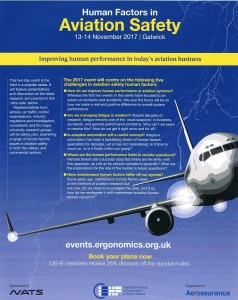


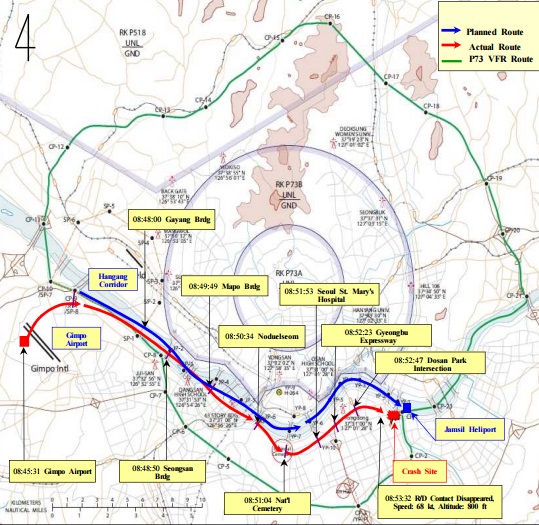
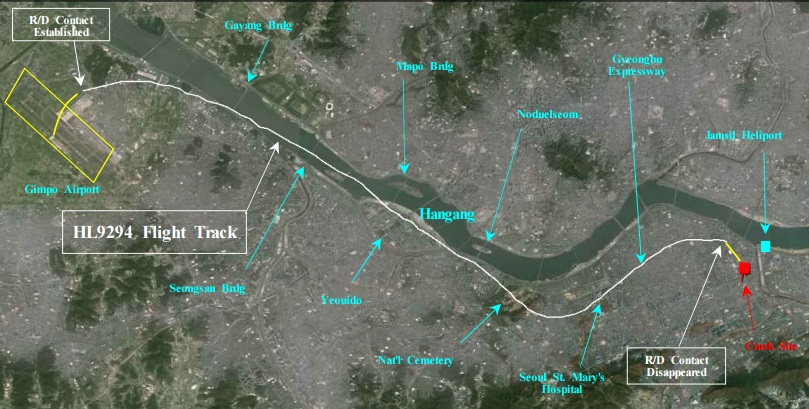

Recent Comments